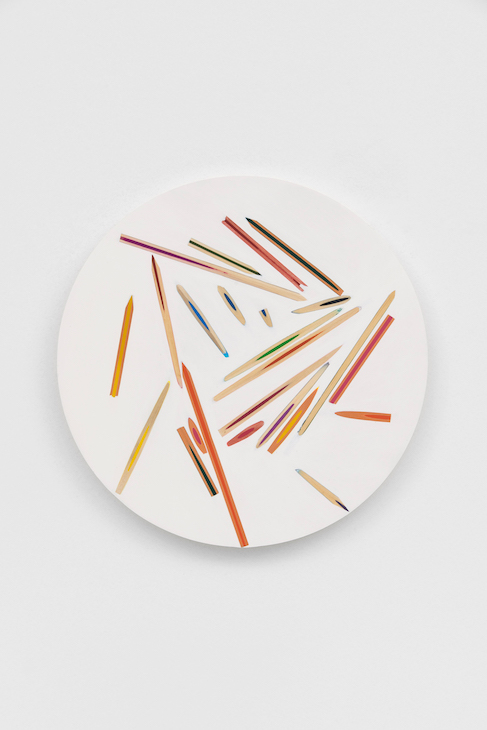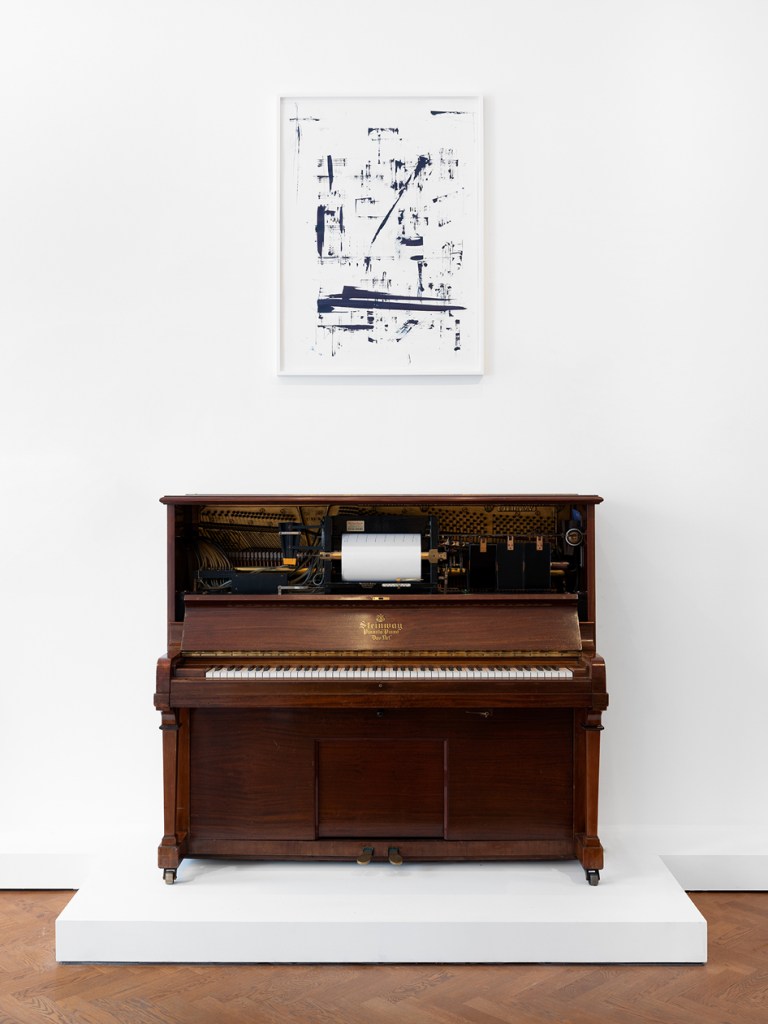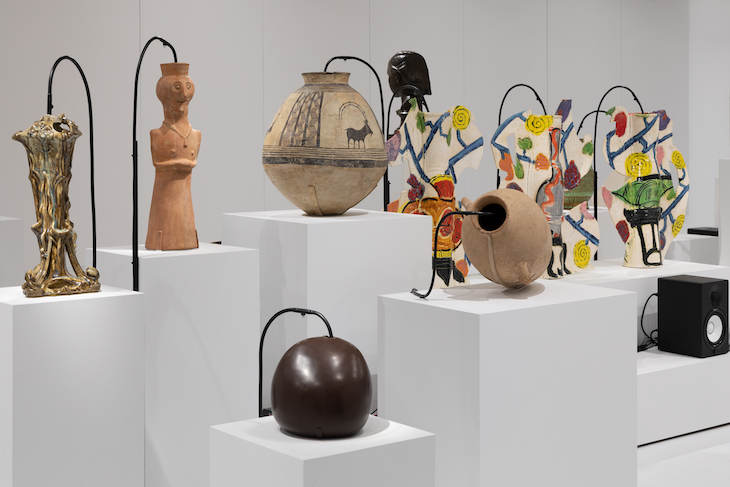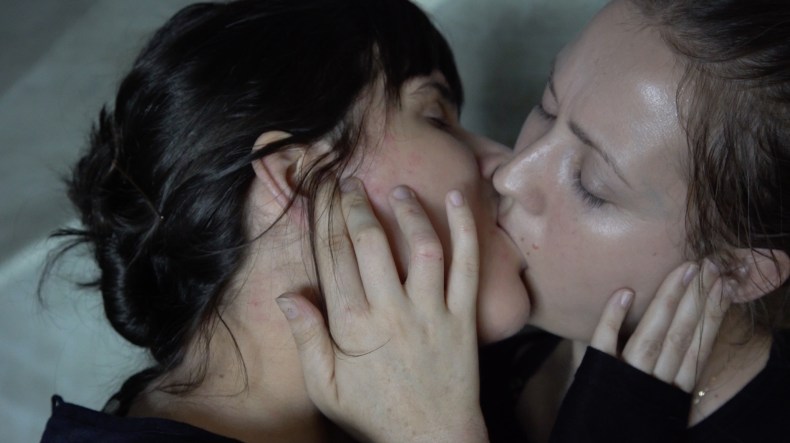As you walk around the several floors of Ely House in London, site of Thaddaeus Ropac’s Mayfair gallery, you will find yourself accompanied by the lilting notes of a piano. The music drifts, seasoned with the resonances and reverberations picked up on its journey down the building’s grand marble staircase and through expansive corridors, subtly inflecting the various works in the galleries with a certain note of wistful, slightly melancholic yearning. The source of these plangent tones is a self-playing pianola – part of Oliver Beer’s current solo exhibition, ‘Oma’, on the ground floor, which also includes a number of sculptural wall works. Beer knows the acoustics of the space well, having created a site-specific vocal composition especially for the gallery’s opening three years ago. But the piano piece currently resounding through these halls is not entirely his own work; for Beer, here, is playing amanuensis to another composer: his own grandmother, whom he referred to as Oma.
Beer was 17 when his grandmother died. ‘I was very influenced by her presence,’ he tells me, ‘because she was just always there. She was so good at telling stories. I felt very closely tied to the history of the 20th century.’ Upon her death, he rolled up the linoleum from her kitchen, ‘because I didn’t want anyone else to walk on it’. Hanging it upright, mottled and variously worn through, on the walls of Modern Art Oxford for a show in 2008 – all 17.5 square metres of it – that battered old lino became, for him, ‘a complete portrait – a self-portrait, really, that she created. You can see: this is where her feet were under her table, this is where she turned round in front of the fridge’. Oma was a keen amateur artist (her paintbrushes and coloured pencils feature, preserved in resin like rare archaeological specimens, in the show at Ropac), but towards the end of her life, at the age of 87, she discovered an urge to compose.
Recomposition (Oma Tondo) (2020), Oliver Beer. Photo: Ben Westoby; courtesy Galerie Thaddaeus Ropac, London, Paris, Salzburg; © Oliver Beer

‘She told me, Ollie, I’ve written this piece of music,’ Beer recalls to me, ‘but it’s all in my head – I’ve got no way of writing it down.’ Like many women of her generation, Beer’s grandmother had been denied the opportunity to study music when she was young. ‘She always said how her father had been a good violinist but had not wanted her to play the violin. And in 1913 it was normal that women should not have the same place in music as men, so she simply wasn’t allowed to learn. Painstakingly, she sang me what she had in her head and I transcribed it and played it on the piano,’ Beer says. It didn’t stop there. ‘She wanted there to be texture, for it to evolve as a proper piano piece. So she drew me what she didn’t realise was a graphic score. Where it became dense and black and large, the music should also be dense and large and when the music was minimal, the drawing was minimal.’ Beer’s reconstruction of that score (the original, sadly, was lost) is framed in the gallery, just above the pianola, and from a distance it looks tantalisingly like a real score: there are the ghosts of staves and clefs in thick black ink strokes. ‘For me, the pathos is in that particular gesture,’ Beer tells me, ‘because it looked like music, but when you got close to it, you could see the absence of all of that formal training.’
Installation view, Oliver Beer, ‘Oma’, Galerie Thaddaeus Ropac, London (12 September–24 October 2020). Photo: Eva Herzog; courtesy Galerie Thaddaeus Ropac, London, Paris, Salzburg; © Oliver Beer

Fifteen year-old Beer, on the contrary, was already fully equipped with that training, having started piano lessons while still in primary school – ‘because a woman was running away from the bailiffs and hid her Steinway in our house as a last resort’. When Oma called on his help with her piece, he had already written his own string quartet and played in bands. ‘I was horribly precocious as a teenager,’ he admits, and sitting across from him in an office on Ropac’s third floor, I can well believe it. He tells me he has always been ‘making all sorts of stuff’. Following an undergraduate degree in music composition, he studied fine art at the Ruskin, then film theory at the Sorbonne – but music continues, he says, to be ‘one of my primary languages’ and informs much of his present work.
While he is disarmingly self-assured, I am charmed nonetheless that – despite our face masks – Beer recognises me from our single previous meeting, some seven years ago. We were at Beer’s 2013 exhibition at Galerie Thaddaeus Ropac in Pantin, in the suburbs of Paris – ‘That was a very important show for me,’ he says. ‘It was just at the start of all this’ – and three tenors, facing the corners like chastised schoolboys, sang peals of notes that seemed to activate the walls themselves, making them ring out and fill the room with soaring harmonies. Every room – every hollow volume, in fact – has a resonant frequency at which it will naturally vibrate and which will induce it to vibrate in sympathy. Much of Beer’s work over the last decade has been concerned with exploiting these frequencies, giving voice to once silent vessels – whether galleries or carparks. A project in 2010, Pay and Display for Ikon Gallery in Birmingham, brought a choir of six to activate the resonant frequencies of the city’s brutalist Pershore Street Car Park. Vessel Orchestra (2019) for the Met Breuer in New York applied the same principle to the museum’s collection; he built a two-and-a-half octave instrument out of the feedback produced by 32 vessels – from an earthenware vase by Joan Miró and Josep Llorens Artigas (which sounded a clear F) to a 7,000-year-old ceramic jar from central Iran (in D). Here, the pianola in ‘Oma’ effectively ventriloquises his grandmother’s silenced voice.
Installation view, ‘Oliver Beer: Vessel Orchestra’, Metropolitan Museum of Art, New York, 2019. Courtesy the Metropolitan Museum of Art, New York; © Oliver Beer

It was one such exercise in releasing the latent voice of a space that led to Beer’s eviction from Sydney Opera House. In 2017, an activist group called Whistleblowers, Activists and Citizens Alliance scaled the swooping fins of the iconic venue in protest at the detainment of refugees on Manus Island. ‘It is a very good reason to be protesting,’ Beer says now, but, at the time, he was deep in the bowels of the building, having explored ‘every nook and cranny of the place’ in order to write a piece especially attuned to it. The national guard was sent in to increase security in the building; it is testament to Beer’s pluck that having once been thrown out, he simply ferreted his way back in and carried on working. It is equally a sign of his ingenuity that when his second expulsion was made rather more insistently, he opted to replace the hollow volume of the opera house with the mouths of his singers, having them press their lips together and sing into each other, each voice resounding in the vocal cavity of the other. The work, titled Composition for Mouths, was shown as part of the 21st Biennale of Sydney in 2018.
Composition for Mouths (Songs My Mother Taught Me) II (still; 2018), Oliver Beer. Courtesy Galerie Thaddaeus Ropac, London, Paris, Salzburg; © Oliver Beer

Throughout these works, Beer regards himself as simply articulating a music that was already quietly present. Whether helping his grandmother to compose or teaching a building to sing, ‘I didn’t create anything as such. I’ve just revealed something that was already there.’
‘Oma’ is at Galerie Thaddaeus Ropac, London, until 24 October.



